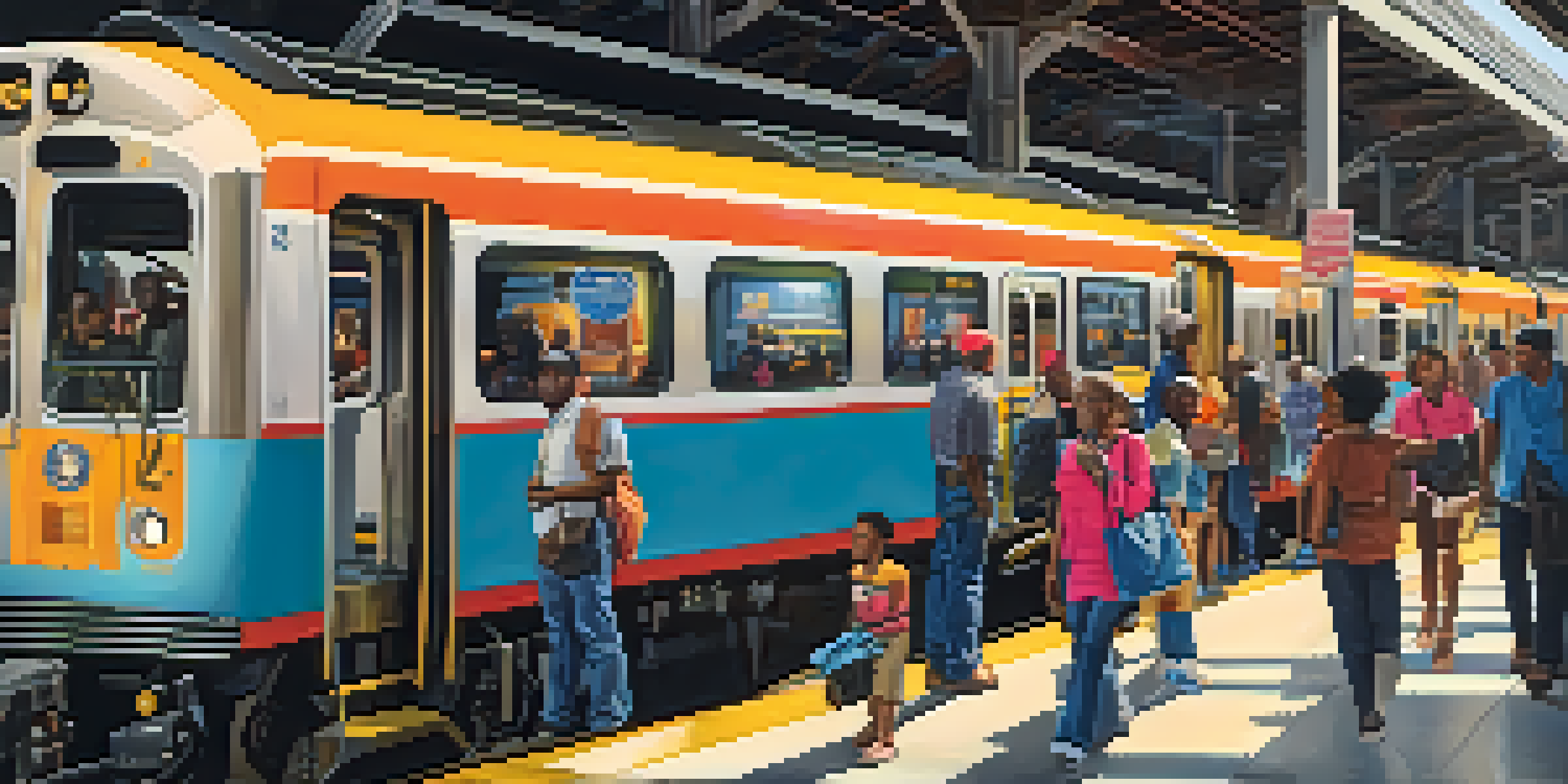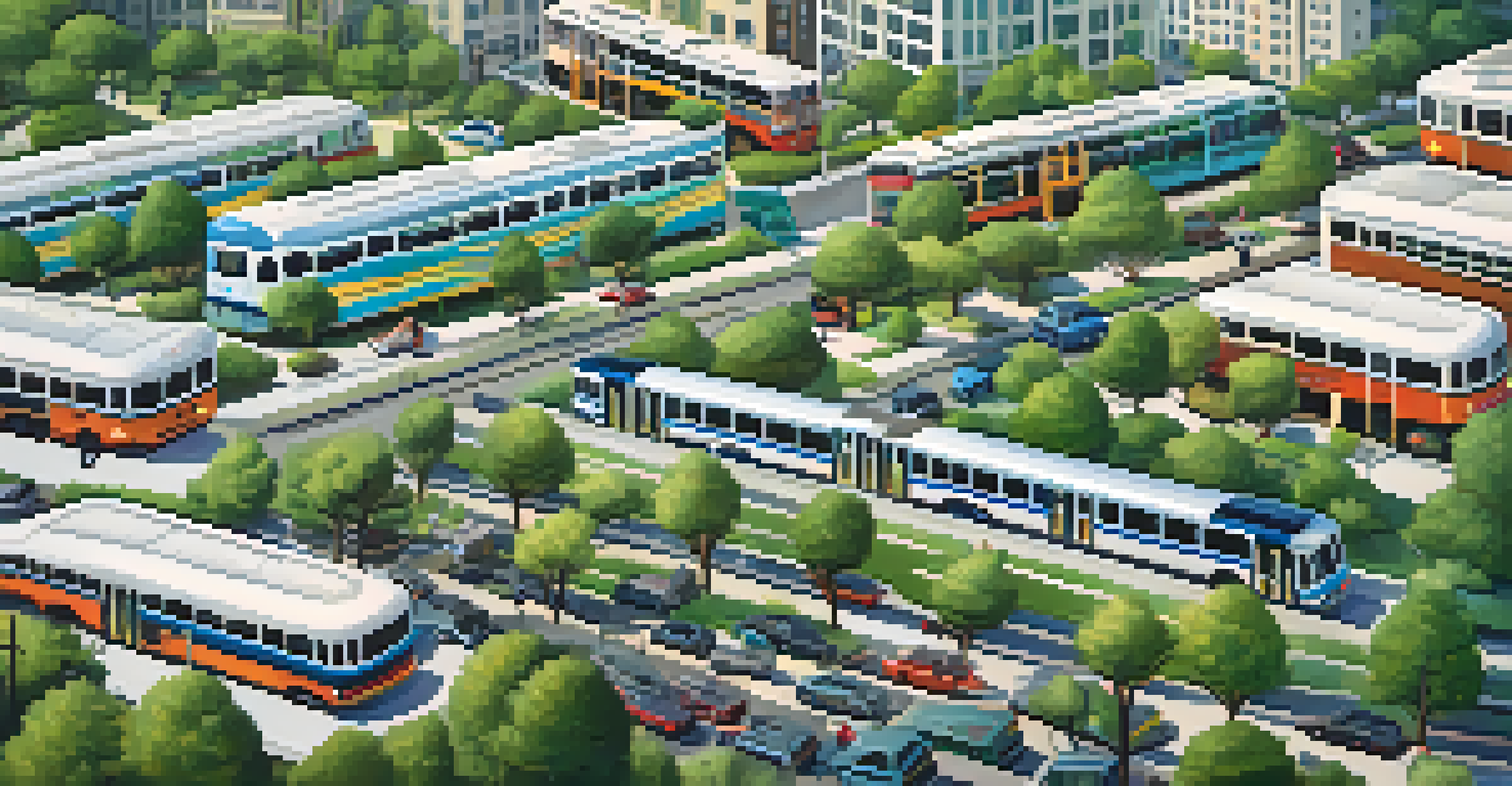Public Transportation in Georgia: An Overview of Options

Overview of Public Transportation in Georgia
Public transportation in Georgia offers a variety of options for residents and visitors. From buses to rail services, these systems aim to provide affordable and efficient travel throughout the state. Understanding the available modes can help you make informed choices about how to get around.
Public transport is not just a means of getting from point A to point B; it’s a vital component of a sustainable urban ecosystem.
Georgia's public transport is not just limited to urban areas; it extends to rural regions, ensuring that even smaller towns have access to essential services. This inclusivity is crucial for connecting communities and promoting accessibility. Whether you’re commuting to work or exploring new areas, public transport can be a convenient alternative.
With ongoing investments and upgrades, the public transportation landscape in Georgia is continually evolving. New routes and services are being introduced to meet the growing demand. This article will delve deeper into the specific options available, helping you navigate the state's transport offerings.
The MARTA System in Atlanta
MARTA, or the Metropolitan Atlanta Rapid Transit Authority, is the backbone of public transportation in Atlanta. It includes both rail and bus services, making it easy to travel around the city and into surrounding areas. For many, MARTA is the most convenient way to avoid traffic and find parking in busy downtown Atlanta.

The rail system comprises four lines that connect key destinations, including the airport, major sporting venues, and popular neighborhoods. Buses complement this network, extending service to areas that are not directly served by rail. This comprehensive system helps residents and tourists alike navigate the bustling city landscape with ease.
Diverse Public Transport Options
Georgia offers a variety of public transportation options, including buses and rail services, to connect urban and rural communities.
MARTA also offers a variety of passes and fare options, catering to different travel needs. Whether you're commuting daily or just visiting for a weekend, there's likely a fare option that suits you best. With its affordability and efficiency, MARTA remains a popular choice for Atlanta's public transportation.
Regional Transit Authorities Across Georgia
Beyond Atlanta, various regional transit authorities serve different parts of Georgia, each with its own unique offerings. For instance, GRTA (Georgia Regional Transportation Authority) focuses on connecting commuters from suburban areas to downtown Atlanta, enhancing accessibility for those who live outside the city.
By investing in public transportation, we invest in the future of our communities and the health of our planet.
Additionally, systems like CobbLinc and Gwinnett County Transit provide bus services tailored to their local communities. These regional transit options play a vital role in supporting residents who rely on public transport for daily activities, such as work, school, and shopping.
By promoting collaboration among various transit authorities, Georgia aims to create a more cohesive public transportation network. This approach not only benefits commuters but also contributes to reducing traffic congestion and lowering carbon emissions across the state.
Biking and Walking: Complementary Transit Options
In addition to traditional public transport, biking and walking are becoming increasingly popular options in Georgia. Many cities, including Atlanta, have been enhancing their infrastructure to support cyclists and pedestrians, making it easier and safer to navigate urban areas without a car.
Bike-sharing programs, like Relay in Atlanta, allow residents and tourists to rent bikes for short trips, promoting a healthy and eco-friendly mode of transport. These programs are often integrated with public transit systems, enabling seamless transitions between biking and other forms of transportation.
Sustainable Transit Initiatives
Public transportation plays a key role in Georgia's sustainability goals by reducing car reliance and lowering greenhouse gas emissions.
Walking remains one of the simplest and most effective ways to explore neighborhoods. With well-maintained sidewalks and pedestrian-friendly areas, residents can enjoy a leisurely stroll while accessing shops, parks, and public transport hubs. This holistic approach to transportation encourages a more sustainable lifestyle.
Rideshare Services: A Modern Alternative
In recent years, rideshare services like Uber and Lyft have transformed the way people navigate Georgia’s cities. These platforms offer a convenient alternative to traditional public transport, especially for those looking for direct routes without the need to transfer between different services.
Rideshare apps can be particularly useful in areas where public transit is limited or during late-night hours when bus and rail services may not be as frequent. They provide flexibility and ease, making them an attractive option for both residents and visitors.
While rideshare services are a great complement to public transportation, it’s essential to be mindful of their environmental impact. Using them judiciously, alongside public transport and other eco-friendly options, can help maintain a balance in urban mobility and reduce overall congestion.
Future Developments in Public Transportation
Georgia is actively working on future developments in public transportation to enhance connectivity and efficiency. Projects like the expansion of MARTA’s rail system and improvements to bus services are underway, aiming to meet the diverse needs of growing populations in various regions.
Innovative technologies are also being explored, such as real-time tracking apps and integrated fare systems that streamline the user experience. These advancements are designed to make public transport more user-friendly and accessible, attracting more people to consider it as a viable commuting option.
Future Developments in Transit
Ongoing projects and innovative technologies are set to enhance Georgia's public transportation system, improving accessibility and user experience.
As public transportation continues to evolve, community input remains vital. Engaging residents in discussions about their needs and preferences helps ensure that future developments align with the expectations of those who rely on these services every day.
Public Transport and Sustainability Goals
Public transportation plays a crucial role in Georgia's sustainability goals by reducing reliance on personal vehicles and lowering greenhouse gas emissions. By promoting public transport, the state encourages more people to leave their cars at home, contributing to cleaner air and a healthier environment.
Efforts to enhance public transport are often coupled with initiatives to promote energy-efficient vehicles and reduce overall carbon footprints. Local governments are increasingly recognizing the importance of integrating sustainability into urban planning, making public transport a key component of their strategies.

As more residents opt for public transportation, the positive impacts on traffic congestion and urban development become evident. By investing in and supporting these systems, Georgia is not just improving mobility; it is also paving the way for a more sustainable future.